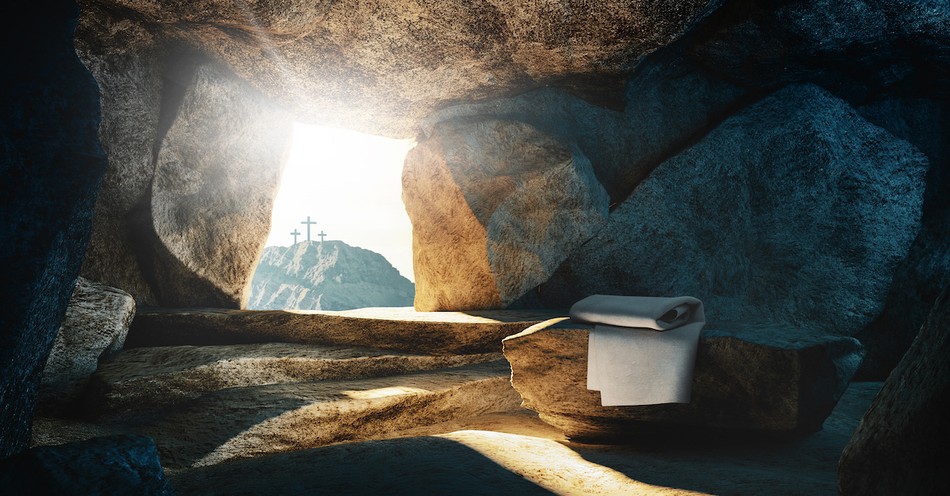They found the stone rolled away from the tomb, but when they entered, they did not find the body of the Lord Jesus. While they were wondering about this, suddenly two men in clothes that gleamed like lightning stood beside them. In their fright the women bowed down with their faces to the ground, but the men said to them, “Why do you look for the living among the dead? He is not here; he has risen! Remember how he told you, while he was still with you in Galilee" - Luke 2:2-6
A popular destination in Jerusalem is the Garden Tomb. At this site, visitors can see an old rock-cut tomb, which many believe may be the tomb in which Jesus’ body was placed after the crucifixion.
While the exact location of Jesus’ burial is uncertain, the Garden Tomb remains a popular site for Christian travelers in the Holy Land. The tomb is empty and provides a visual example of what Jesus’ burial site may have looked like after the stone was rolled away on the day of His resurrection.
When the women found the stone rolled away on that early Easter morning, they knew something significant had occurred. Not only had the stone been rolled away from the entrance, but there was also no body inside the tomb.
Jesus did not secretly hide His resurrection, but rather deliberately left visible indications of His resurrection through an open and empty tomb.
Significantly, the fact that the stone was rolled away when the women chose to visit the tomb provides verifiable evidence to the miraculous event of the resurrection.
The Importance of the Rolling Stone
Tombs during the days of Jesus differ from modern graves and mausoleums. Because Jesus was buried in a tomb owned by the wealthy Joseph of Arimathea, the tomb was new and able to be sealed with a rolling stone (Mark 15:46).
Such tombs were commonly hewn out of rock and were sealed with a heavy stone to close the entrance. Clearly, such a stone to be rolled over the entrance to the tomb would require multiple people and a lot of strength to move.
Joseph of Arimathea did not push the stone in place by himself, but rather had the assistance of Nicodemus, who was also a follower of Christ (John 19:39-42). The strength of both men would have been required to roll the large circular stone to close Jesus’ place of burial.
The women were present when Joseph of Arimathea and Nicodemus prepared the body and placed Jesus in the tomb (Mark 15:46). They understood the weight of the stone placed over the tomb of Jesus.
Observing where Jesus’ body was placed, in Nicodemus’ new family tomb, the women took note of the spot with the plans to return after the Sabbath to lovingly anoint the body (Mark 16:1-2). On that Sunday morning, however, they would question how they would roll back the heavy stone to enter the tomb (Mark 16:3).
The Women Find the Stone Rolled Away
Miraculously, the women did not have to wonder for too long as to whom would roll the stone away, for when they arrived at the place of Jesus’ burial, “[t]hey found the stone rolled away from the tomb” (Luke 24:2, NIV).
Closely connected to the stone being rolled away from the entrance was the undeniable fact of the empty tomb. In Luke’s gospel, right after the women find that the stone was rolled away, they entered the tomb to find it empty with no trace of Jesus’ body (Luke 24:2).
Such an unexpected turn of events shocked the women and left them puzzled (Luke 24:4). In fact, John’s gospel describes Mary Magdalene being distraught after she found the stone rolled away and Jesus’ body gone, which she mistakenly assumed was stolen (John 20:1-2).
Since the women did not know what to make of these miraculous signs, the Lord sent angels to carry the message of the resurrection.
At the empty tomb, the angels delivered the good news: “‘Why do you look for the living among the dead? He is not here; he has risen! Remember how he told you, while he was still with you in Galilee: ‘The Son of Man must be delivered over to the hands of sinners, be crucified and on the third day be raised again’” (Luke 24:5-7, NIV).
The women followers of Jesus were the first ones to learn of Jesus’ resurrection because they found the stone had been rolled away from the entrance to the tomb on that early Easter morning.
Verifiable Evidence
Jesus did not have a secret resurrection. Anyone could go to the tomb and see that Jesus’ body was no longer inside. For the women who visited the tomb, the moved stone and vacant tomb were verifiable evidence of Jesus’ resurrection.
The description of the events in the early morning was no doubt included in the women’s message to the disciples when they spread the life-changing news (Luke 24:9-11).
Because Jesus deliberately included these details on the day of His resurrection shows that He wants people to investigate the truth and know what happened.
Examining and discerning the evidence is what Peter did when he went to the tomb. As John 20:6-7 states, “He saw the strips of linen lying there, as well as the cloth that had been wrapped around Jesus’ head. The cloth was still lying in its place, separate from the linen” (NIV).
Specifically, the Greek word translated “saw” in verse six carries the meaning of discerning or looking attentively into (Strong’s Greek: 2334). Peter was attentively investigating the evidence of the empty tomb.
Today, people can still examine the evidence that Jesus left behind through the accounts of the gospels. All four gospels include the events of the resurrection, which individuals can read and study for themselves (Matthew 28; Mark 16; Luke 24; John 20).
Specifically, in Luke’s gospel, he took the time to gather extensive eyewitness reports, which included the women who went to the tomb on the day of the resurrection (Luke 1:1-4; 24:10). The rolled away stone and empty tomb continue to serve as evidence of the resurrection.
A Significant Stone
A rolling stone used to seal a tomb may not seem very special, but because the stone had been rolled away from Christ’s place of burial, it left evidence of an empty tomb with no body. Such happenings testify to the truth of the resurrection of Jesus Christ, the most important event in history.
Christ did not secretly raise from the dead or hide His resurrection but left verifiable and clear evidence to the truth that He had been raised from the dead. Even today, people can still read of the events of the resurrection, explore the evidence in the Bible, and know that Jesus is indeed risen (Matthew 28:6).
For further reading:
Why Didn’t the Disciples Recognize Jesus after His Resurrection?
Where Was Jesus During the Three Days Before His Resurrection?
Why Do We Say ‘He Has Risen’ During Easter?
Photo Credit: ©iStock/Getty Images Plus/AlessandroPhoto





